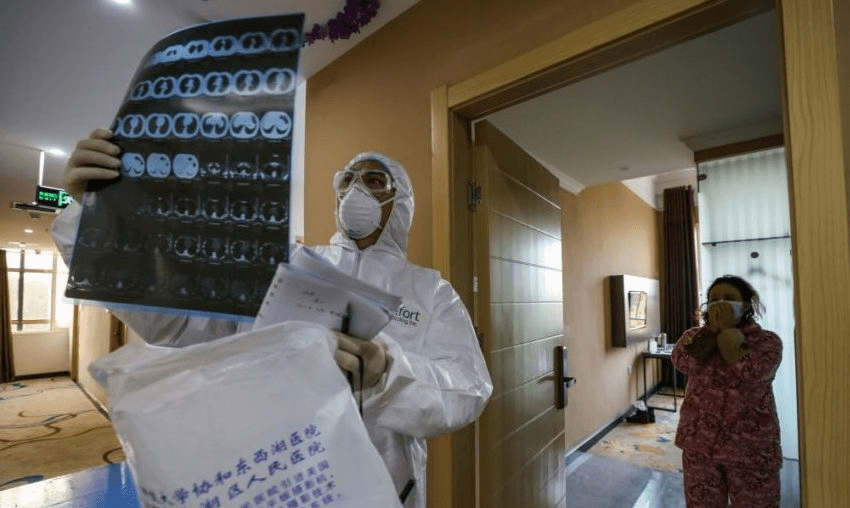A new report on the Covid-19 outbreak has some important insights into the way it has progressed, the severity of cases, and why we should be taking it very seriously. Siouxsie Wiles explains.
The Spinoff’s ongoing coverage of the Covid-19 outbreak is made possible thanks to Spinoff Members. To support our journalism join members here.
In February a team from the World Health Organisation went to China to work with health officials there on a joint mission to understand the evolving Covid-19 outbreak. They’ve just released their report which tells us quite a bit about this new disease.
The first thing to say about the data in the report is that it shows that the Chinese have managed to get ahead of the virus. As you can see from the chart (apologies for the small text on mobile; but you’ll be able to see the trend), the number of new confirmed cases peaked in late January/early February and is now falling.
This is not the time to be complacent though. Numbers could easily rise again if the conditions are right.
Many infections were classed as mild/moderate but that doesn’t necessarily mean what you think it does
Analysis of almost 56,000 lab confirmed cases found that people with the virus ranged in age from two days old to 100 years old. More than three-quarters of the people were aged between 30 and 69. There was a fairly even split between men and women.
The report describes how people with Covid-19 generally develop signs and symptoms on average about five or six days after contracting the virus. It’s says that about eight out of 10 people had mild to moderate disease, just over one in 10 had severe disease, and just over one in 20 were critical. They also say that some people initially tested positive for the virus even though they had no symptoms, but almost all of them went on to develop disease.
I’ve seen a lot of people online suggesting that as most people get “mild” disease, Covid-19 is not worth worrying about. They might want to rethink that. According to the report, it took people about two weeks to recover from a mild/moderate illness. So “mild/moderate” Covid-19 is probably more like a pretty nasty chest infection or flu rather than a case of the sniffles.
People with severe disease experienced shortness of breath and respiratory distress, as well as respiratory failure, septic shock, and/or multiple organ failure. In these cases, it took more like three to six weeks for them to recover. That will be why less than half of the confirmed cases are recorded as having recovered.
It’s worth noting that according to this chart in the report even some people with mild and moderate disease went on to die of Covid-19.
It’s essential we protect the vulnerable
The WHO report clearly shows that people with underlying health conditions like hypertension, diabetes, cardiovascular disease, chronic respiratory disease, and cancer are most at risk of getting severe disease and dying. The same is true for those over 60. If you are in your teens, 20s, or 30s, the case fatality rate looks to be about 0.2%. If you are in your 40s it’s about 0.4% and if you are in your 50s it’s 1.3%. But if you are in your 60s it jumps to 3.6%, in your 70s it’s 8% and if you are over 80 it’s 14.8%.
This is why it is so important that anyone who suspects they have contracted the virus isolate themselves and seek medical help. You may just have a crappy couple of weeks in store, but the consequences for others around you could be much more serious. I’m concerned about how people living in countries with no or very little paid sick leave (yes, I’m looking at you, New Zealand) are going to manage if they find themselves in this position.
Pregnant women and those with newborns should as in with all infectious diseases take special care.
Droplet not airborne spread
The reports states that the virus is transmitted “via droplets and fomites during close unprotected contact”. Fomites are inanimate objects that have been contaminated with virus when people cough and sneeze. When scientists say an infectious agent is airborne, they mean that the microbe is present in very small droplets that can remain in the air for a while. This is not happening in the case of the Covid-19 virus. Instead it is present in large droplets which quickly fall, contaminating the surrounding surfaces. Hence the fomites. The virus has been found in the poop of some patients but that doesn’t seem important in transmission from the cases to date.
Most transmission has been within households
In China, transmission of the Covid-19 virus has mostly happened in families, which fits with the need for close contact to contract the infection. One study has put it at around 80% of cases. This means you are unlikely to pick up the virus just walking down the street or having casual contact with someone. And even if you are in a close contact with someone, preliminary analysis of the household clusters suggests less than one in 10 households see any transmission of the virus. That may be because people are taking all the right precautions around handwashing and cough/sneeze etiquette.
Everyone needs to get ready
The report ends with a stark warning: much of the global community isn’t mentally and physically ready for Covid-19. Their message to the public is very clear. Covid-19 is a serious disease and we can all play a role in preventing its spread. That starts with getting into the habit of washing our hands more frequently and learning how to cough and sneeze properly.
For a more comprehensive no-panic practical guide on preparing for Covid-19 read this.

